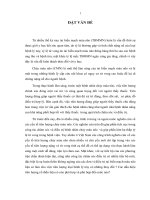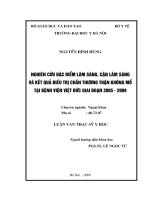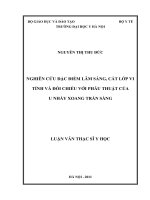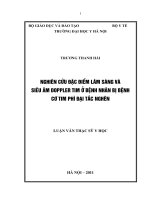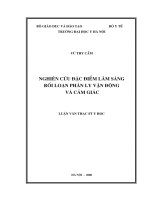Nghiên cứu đặc điểm lâm sàng rách sụn chêm do chấn thương
Bạn đang xem bản rút gọn của tài liệu. Xem và tải ngay bản đầy đủ của tài liệu tại đây (558.12 KB, 8 trang )
����������������������������������������������������������������������������������������������������������������������������������������������������������������������������������������������������������������������������������������������������������������������������������������������������������������������������������������������������������������������������������������������������������������������������������������������������������������������������������������������������������������������������������������������������������������������������������������������������������������������������������������������������������������������������������������������������������������������������������������������������������������������������������������������������������������������������������������������������������������������������������������������������������������������������������������������������������������������������������������������������������������������������������������������������������������������������������������������������������������������������������������������������������������������������������������������������������������������������������������������������������������������������������������������������������������������������������������������������������������������������������������������������������������������������������������������������������������������������������������������������������������������������������������������������������������������������������������������������������������������������������������������������������������������������������������������������������������������������������������������������������������������������������������������������������������������������������������������������������������������������������������������������������������������������������������������������������������������������������������������������������������������������������������������������������������������������������������������������������������������������������������������������������������������������������������������������������������������������������������������������������������������������������������������������������������������������������������������������������������������������������������������������������������������������������������������������������������������������������������������������������������������������������������������������������������������������������������������������������������������������������������������������������������������������������������������������������������������������������������������������������������������������������������������������������������������������������������������������������������������������������������������������������������������������������������������������������������������������������������������������������������������������������������������������������������������������������������������������������������������������������������������������������������������������������������������������������������������������������������������������������������������������������������������������������������������������������������������������������������������������������������������������������������������������������������������������������������������������������������������������������������������������������������������������������������������������������������������������������������������������������������������������������������������������������������������������������������������������������������������������������������������������������������������������������������������������������������������������������������������������������������������������������������������������������������������������������������������������������������������������������������������������������������������������������������������������������������������������������������������������������������������������������������������������������������������������������������������������������������������������������������������������������������������������������������������������������������������������������������������������������������������������������������������������������������������������������������������������������������������������������������������������������������������������������������������������������������������������������������������������������������������������������������������������������������������������������������������������������������������������������������������������������������������������������������������������������������������������������������������������������������������������������������������������������������������������������������������������������������������������������������������������������������������������������������������������������������������������������������������������������������������������������������������������������������������������������������������������������������������������������������������������������������������������������������������������������������������������������������������������������������������������������������������������������������������������������������������������������������������������������������������������������������������������������������������������������������������������������������������������������������������������������������������������������������������������������������������������������������������������������������������������������������������������������������������������������������������������������������������������������������������������������������������������������������������������������������������������������������������������������������������������������������������������������������������������������������������������������������������������������������������������������������������������������������������������������������������������������������������������������������������������������������������������������������������������������������������������������������������������������������������������������������������������������������������������������������������������������������������������������������������������������������������������������������������������������������������������������������������������������������������������������������������������������������������������������������������������������������������������������������������������������������������������������������������������������������������������������������������������������������������������������������������������������������������������������������������������������������������������������������������������������������������������������������������������������������������������������������������������������������������������������������������������������������������������������������������������������������������������������������������������������������������������������������������������������������������������������������������������������������������������������������������������������������������������������������������������������������������������������������������������������������������������������������������������������������������������������������������������������������������������������������������������������������������������������������������������������������������������������������������������������������������������������������������������������������������������������������������������������������������������������������������������������������������������������������������������������������������������������������������������������������������������������������������������������������������������������������������������������������������������������������������������������������������������������������������������������������������������������������������������������������������������������������������������������������������������������������������������������������������������������������������������������������������������������������������������������������������������������������������������������������������������������������������������������������������������������������������������������������������������������������������������������������������������������������������������������������������������������������������������������������������������������������������������������������������������������������������������������������������������������������������������������������������������������������������������������������������������������������������������������������������������������������������������������������������������������������������������������������������������������������������������������������������������������������������������������������������������������������������������������������������������������������������������������������������������������������������������������������������������������������������������������������������������������������������������������������������������������������������������������������������������������������������������������������������������������������������������������������������������������������������������������������������������������������������������������������������������������������������������������������������������������������������������������������������������������������������������������������������������������������������������������������������������������������������������������������������������������������������������������������������������������������������������������������������������������������������������������������������������������������������������������������������������������������������������������������������������������������������������������������������������������������������������������������������������������������������������������������������������������������������������������������������������������������������������������������������������������������������������������������������������������������������������������������������������������������������������������������������������������������������������������������������������������������������������������������������������������������������������������������������������������������������������������������������������������������������������������������������������������������������������������������������������������������������������������������������������������������������������������������������������������������������������������������������������������������������������������������������������������������������������������������������������������������������������������������������������������������������������������������������������������������������������������������������������������������������������������������������������������������������������������������������������������������������������������������������������������������������������������������������������������������������������������������������������������������������������������������������������������������������������������������������������������������������������������������������������������������������������������������������������������������������������������������������������������������������������������������������������������������������������������������������������������������������������������������������������������������������������������������������������������������������������������������������������������������������������������������������������������������������������������������������������������������������������������������������������������������������������������������������������������������������������������������������������������������������������������������������������������������������������������������������������������������������������������������������������������������������������������������������������������������������������������������������������������������������������������������������������������������������������������������������������������������������������������������������������������������������������������������������������������������������������������������������������������������������������������������������������������������������������������������������������������������������������������������������������������������������������������������������������������������������������������������������������������������������������������������������������������������������������������������������������������������������������������������������������������������������������������������������������������������������������������������������������������������������������������������������������������������������������������������������������������������������������������������������������������������������������������������������������������������������������������������������������������������������������������������������������������������������������������������������������������������������������������������������������������������������������������������������������������������������������������������������������������������������������������������������������������������������������������������������������������������������������������������������������������������������������������������������������������������������������������������������������������������������������������������������������������������������������������������������������������������������������������������������������������������������������������������������������������������������������������������������������������������������������������������������������������������������������������������������������������������������������������������������������������������������������������������������������������������������������������������������������������������������������������������������������������������������������������������������������������������������������������������������������������������������������������������������������������������������������������������������������������������������������������������������������������������������������������������������������������������������������������������������������������������������������������������������������������������������������������������������������������������������������������������������������������������������������������������������������������������������������������������������������������������������������������������������������������������������������������������������������������������������������������������������������������������������������������������������������������������������������������������������������������������������������������������������������������������������������������������������������������������������������������������������������������������������������������������������������������������������������������������������������������������������������������������������������������������������������������������������������������������������������������������������������������������������������������������������������������������������������������������������������������������������������������������������������������������������������������������������������������������������������������������������������������������������������������������������������������������������������������������������������������������������������������������������������������������������������������������������������������������������������������������������������������������������������������������������������������������������������������������������������������������������������������������������������������������������������������������������������������������������������������������������������������������������������������������������������������������������������������������������������������������������������������������������������������������������������������������������������������������������������������������������������������������������������������������������������������������������������������������������������������������������������������������������������������������������������������������������������������������������������������������������������������������������������������������������������������������������������������������������������������������������������������������������������������������������������������������������������������������������������������������������������������������������������������������������������������������������������������������������������������������������������������������������������������������������������������������������������������������������������������������������������������������������������������������������������������������������������������������������������������������������������������������������������������������������������������������������������������������������������������������������������������������������������������������������������������������������������������������������������������������������������������������������������������������������������������������������������������������������������������������������������������������������������������������������������������������������������������������������������������������������������������������������������������������������������������������������������������������������������������������������������������������������������������������������������������������������������������������������������������������������������������������������������������������������������������������������������������������������������������������������������������������������������������������������������������������������������������������������������������������������������������������������������������������������������������������������������������������������������������������������������������������������������������������������������������������������������������������������������������������������������������������������������������������������������������������������������������������������������������������������������������������������������������������������������������������������������������������������������������������������������������������������������������������������������������������������������������������������������������������������������������������������������������������������������������������������������������������������������������������������������������������������������������������������������������������������������������������������������������������������������������������������������������������������������������������������������������������������������������������������������������������������������������������������������������������������������������������������������������������������������������������������������������������������������������������������������������������������������������������������������������������������������������������������������������������������������������������������������������������������������������������������������������������������������������������������������������������������������������������������������������������������������������������������������������������������������������������������������������������������������������������������������������������������������������������������������������������������������������������������������������������������������������������������������������������������������������������������������������������������������������������������������������������������������������������������������������������������������������������������������������������������������������������������������������������������������������������������������������������������������������������������������������������������������������������������������������������������������������������������������������������������������������������������������������������������������������������������������������������������������������������������������������������������������������������������������������������������������������������������������������������������������������������������������������������������������������������������������������������������������������������������������������������������������������������������������������������������������������������������������������������������������������������������������������������������������������������������������������������������������������������������������������������������������������������������������������������������������������������������������������������������������������������������������������������������������������������������������������������������������������������������������������������������������������������������������������������������������������������������������������������������������������������������������������������������������������������������������������������������������������������������������������������������������������������������������������������������������������������������������������������������������������������������������������������������������������������������������������������������������������������������������������������������������������������������������������������������������������������������������������������������������������������������������������������������������������������������������������������������������������������������������������������������������������������������������������������������������������������������������������������������������������������������������������������������������������������������������������������������������������������������������������������������������������������������������������������������������������������������������������������������������������������������������������������������������������������������������������������������������������������������������������������������������������������������������������������������������������������������������������������������������������������������������������������������������������������������������������������������������������������������������������������������������������������������������������������������������������������������������������������������������������������������������������������������������������������������������������������������������������������������������������������������������������������������������������������������������������������������������������������������������������������������������������������������������������������������������������������������������������������������������������������������������������������������������������������������������������������������������������������������������������������������������������������������������������������������������������������������������������������������������������������������������������������������������������������������������������������������������������������������������������������������������������������������������������������������������������������������������������������������������������������������������������������������������������������������������������������������������������������������������������������������������������������������������������������������������������������������������������������������������������������������������������������������������������������������������������������������������������������������������������������������������������������������������������������������������������������������������������������������������������������������������������������������������������������������������������������������������������������������������������������������������������������������������������������������������������������������������������������������������������������������������������������������������������������������������������������������������������������������������������������������������������������������������������������������������������������������������������������������������������������������������������������������������������������������������������������������������������������������������������������������������������������������������������������������������������������������������������������������������������������������������������������������������������������������������������������������������������������������������������������������������������������������������������������������������������������������������������������������������������������������������������������������������������������������������������������������������������������������������������������������������������������������������������������������������������������������������������������������������������������������������������������������������������������������������������������������������������������������������������������������������������������������������������������������������������������������������������������������������������������������������������������������������������������������������������������������������������������������������������������������������������������������������������������������������������������������������������������������������������������������������������������������������������������������������������������������������������������������������������������������������������������������������������������������������������������������������������������������������������������������������������������������������������������������������������������������������������������������������������������������������������������������������������������������������������������������������������������������������������������������������������������������������������������������������������������������������������������������������������������������������������������������������������������������������������������������������������������������������������������������������������������������������������������������������������������������������������������������������������������������������������������������������������������������������������������������������������������������������������������������������������������������������������������������������������������������������������������������������������������������������������������������������������������������������������������������������������������������������������������������������������������������������������������������������������������������������������������������������������������������������������������������������������������������������������������������������������������������������������������������������������������������������������������������������������������������������������������������������������������������������������������������������������������������������������������������������������������������������������������������������������������������������������������������������������������������������������������������������������������������������������������������������������������������������������������������������������������������������������������������������������������������������������������������������������������������������������������������������������������������������������������������������������������������������������������������������������������������������������������������������������������������������������������������������������������������������������������������������������������������������������������������������������������������������������������������������������������������������������������������������������������������������������������������������������������������������������������������������������������������������������������������������������������������������������������������������������������������������������������������������������������������������������������������������������������������������������������������������������������������������������������������������������������������������������������������������������������������������������������������������������������������������������������������������������������������������������������������������������������������������������������������������������������iệu hạn chế, điều này
chúng tôi chưa thể so sánh với những nghiên
cứu lớn hơn. Tuy với những số liệu dù chưa
nhiều nhưng chúng tôi cũng cho thấy tính khả
thi của phương pháp điều trị TAE trong chấn
thương lách phức tạp và nặng trong một số
trường hợp.
Trong số liệu của chúng tôi, có một trường
hợp chấn thương vỡ gan thất bại bằng phương
pháp điều trị thuyên tắc mạch phải chuyển mổ.
Khi lựa chọn vật liệu gây tắc, chúng tôi đã sử
dụng gelfoam, vật liệu gây tắc không vĩnh viễn,
mặc dù việc khảo sát kiểm tra ngay sau khi tắc
không cho thấy bất thường nào, nhưng khi rút
microcatheter ra và kiểm tra động mạch thân
tạng qua ống thông lớn lại ghi nhận mạch máu
tái thông và động mạch tổn thương không tắc
hoàn toàn. Quyết định ngưng thủ thuật khi
huyết động bệnh nhân bắt đầu có dấu hiệu bất
ổn và chuyển sang mổ hở. Qua đó cho thấy, việc
lựa chọn vật liệu gây tắc là rất quan trọng.
Những trường hợp khác chúng tôi đều sử dụng
hỗn hợp keo sinh học và lipiodol đem lại thành
công tắc mạch tuyệt đối.
TÀI LIỆU THAM KHẢO
1.
Adrian AM, Lewis JK (2012). Management of splenic injury in
adult trauma patient. Up to date 2012; 1 – 16.
2. Akiyoshi Hagirawa et al (1997). Nonsurgical management of
patients with blunt hepatic trauma: Efficacy of transcatheter
arterial embolization. AJR 1997; 169: 1151 – 1157.
3. Asensio JA, RoldanG, Petrone. Et al (2003). Operative
management and outcomes in 103 AAST – OIS grades IV and V
complex hepatic injuries: trauma surgeon still need to operate
but angioembolisation helps. J Trauma 2003; 54: 647 – 653.
4. Bass EM, Crosier JH (1977). Percutaneous control of post
traumatic hepatic haemorrhage by gelfoam embolization. J
Trauma 1977; 17: 61 – 63.
5. Clancy TV, Maxwell JG, Covington DL, et al (2001). A statewide
analysis of level I and II trauma centers for patients with major
injuries. J Trauma 2001; 51:346 – 512.
6. Duane TM, Como JJ, Bochicchio GV, Scalea TM (2004).
Reevaluating the management and outcomes of severe blunt
liver injury. J Trauma 2004; 57:494 – 500.
7. Farnell MB, Spencer MP, Thompson E, Williams HJ, Much P,
Ilstrup DM. Nonoperative management of blunt hepatic trauma
in adults. Surgery 1988; 104: 148 – 156.
8. Foley WD, Ctes JD, Kellmann GM et al (1987). Treatment of
blunt hepatic injuries; role of CT. Radiology; 1987; 164: 635 – 638
9. Gaarder C, Naess PA, Eken T, Skaga NO, Pillgram‐Larsen J,
Klow NE, Buanes T. Buanes. Liver injuries – Improved results
with a formal protocol including angiography. Injury, Int. J.
Care injuried 2007; 38: 1075 – 1083.
10. Haan J, Ilahi ON, Kramer M et al (2003). Protocol driven non
operative management with blunt splenic trauma and minimal
associated injury decreases length of stay. J Trauma, 2003;
55:317.
Hội Nghị Khoa Học Công Nghệ BV. Nhân Dân Gia Định năm 2013
243
Y Học TP. Hồ Chí Minh * Tập 17 * Số 6 * 2013
Nghiên cứu Y học
11. Haan JM, Biffl W, Knudson M et al (2004). Splenic embolization
revisited: a multicenter review. J Trauma 2004; 56: 542.
12. Holdens A et al. (2008) Abdomen‐intervention for solid organ
injury. Injury, Int. J. Care injured 2008; 39: 1275 – 1289.
13. Jander HP, Laws HL, Kogutt MS, Mihas AA. Emergency
embolization in blunt hepatic trauma. AJR 1977, 129: 249 – 252.
14. Knudson MM, Lim RC, Oaks DD, Jeffrey RB Jr (1990).
Nonoperative management of blunt liver injuries in adult: the
needs for continued surveillance. J Trauma 1990; 30: 1494 – 1550.
15. Liu PP, Lee WC, Cheng YF et al (2004). Use of splenic artery
embolization as an adjunct to nonsurgical management of blunt
splenic injury. J Trauma 2004; 56:768.
16. Merdith JW, Young JS, Bowling J, et al (1994). Non operative
management of blunt hepatic trauma: the exception or the rule.
J Trauma 1994; 36: 529 – 535.
17. Mirvis SE, Whitley NO, Vainwright JR, Gens DR (1989). Blunt
hepatic trauma: CT – based classification and correlation with
prognostic and treatment. Radiology 1989; 171: 27 – 32.
18. Ong CC, Toh L, Lo RH, Yap TL, Narasimhan K (2012). Primary
hepatic artery embolization in pediatric blunt hepatic trauma.
Journal of Pediatric Surgery; 47: 2316 – 2320.
19. Pachter HL (1995), Hofstetter SR. The current status of non‐
operative management of adult blunt hepatic injuries. AmJ Surg
1995; 169: 442 – 454.
20. Pachter HL, Knudson MM, Esrig B, et al (1996). Status of
nonoperative management of blunt hepatic injuries in 1995: a
multicenter experiences with 404 patients. J Trauma, 1996; 40: 31
– 38.
21. Pachter HL, Spencer FC, Hofstetter SR, Liang HG (1992), Coppa
22.
23.
24.
25.
26.
27.
GF. Significant trend in the treatment of hepatic trauma:
experience of 411 injuries. Ann Surg 1992; 215: 492 – 502.
Rajani RR, Claridge JA, Yowler CJ et al (2006). Improved
outcome of adult blunt splenic injury: a cohort analysis. Surgery
2006; 140:625.
Sabe AA, Claridge JR, Rosenblum DI et al (2009). The effects of
splenic artery embolization on nonoperative management of
blunt splenic injury: a 16‐year experience. J Trauma 2009;
67:565.
Shanuganathan K, Mirvis SE, Chiu WC (2004). Penatrating
torso trauma: triplecontrast helical CT in peritoneal violation
and organ injury. A prospecstudy in 200 patients. Radiology
2004; 231: 775 – 84.
Sugimoto K, Asari Y, Sakaguchi T, et al (1993). Endoscopic
retrograde cholangiography in nonsurgical management of
blunt liver trauma. J Trauma 1993; 35: 192 – 199.
Taourel P, Vernet H, Suau A, Granier C, Lopez FM (2007),
Aufort S. Vascular emergencies in liver trauma. European Journal
of Radiology 2007; 64: 73 – 82.
Trần Chánh Tín, Nguyễn Hải Lê, Nguyễn Bá Nhuận, Nguyễn
Tấn Cường, Bùi Văn Ninh (2003). Chẩn đoán chấn thương bụng
kín. Tạp chí y học TP.HCM 2003, Tập 7, số 1.
Ngày nhận bài báo
: 15/8/2013
Ngày phản biện nhận xét bài báo : 21/08/2013
Ngày bài báo được đăng
: 10/12/2013.
244
Hội Nghị Khoa Học Công Nghệ BV. Nhân Dân Gia Định năm 2013
